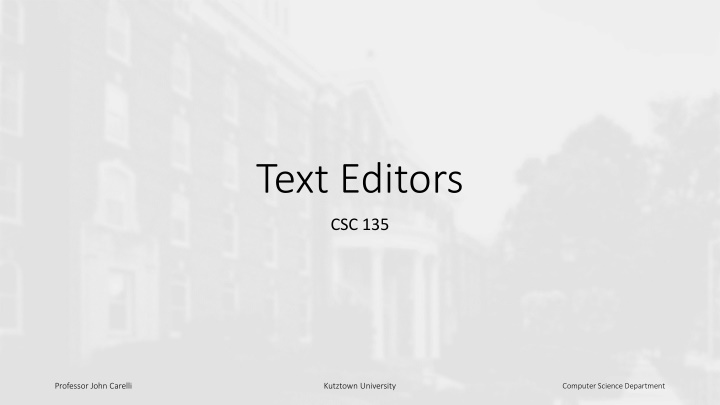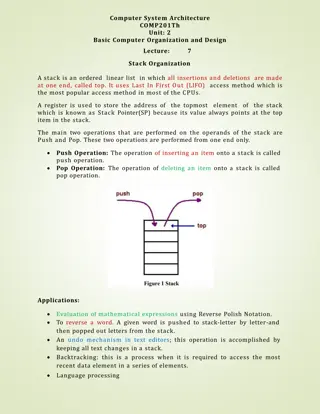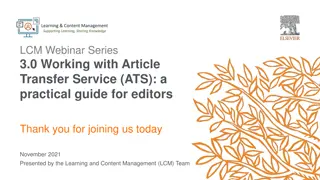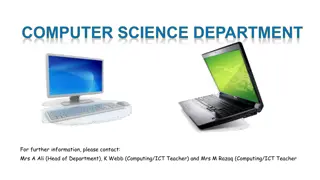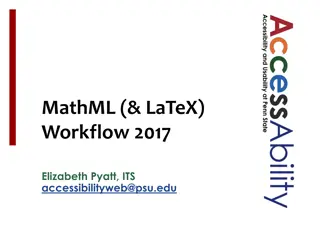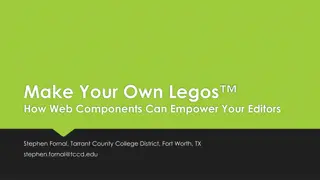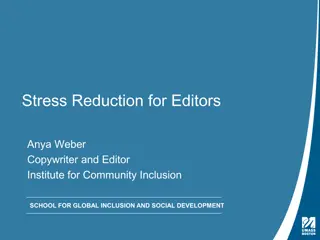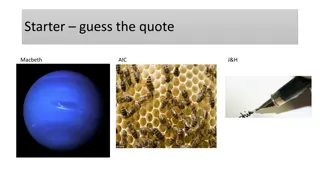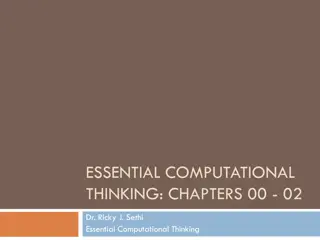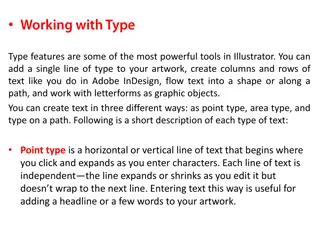Text Editors in Computer Science
This content delves into various text editors commonly utilized in the computer science field. It covers Unix, Emacs, Nano, and Vim, explaining their functionalities and highlighting their importance in editing text files within a command-based operating system. The detailed descriptions are provided to understand the key features and basic usage of these text editors, with insights shared by Professor John Carelli from Kutztown University's Computer Science Department.
Download Presentation

Please find below an Image/Link to download the presentation.
The content on the website is provided AS IS for your information and personal use only. It may not be sold, licensed, or shared on other websites without obtaining consent from the author.If you encounter any issues during the download, it is possible that the publisher has removed the file from their server.
You are allowed to download the files provided on this website for personal or commercial use, subject to the condition that they are used lawfully. All files are the property of their respective owners.
The content on the website is provided AS IS for your information and personal use only. It may not be sold, licensed, or shared on other websites without obtaining consent from the author.
E N D
Presentation Transcript
Text Editors CSC 135 Professor John Carelli Kutztown University Computer Science Department
Text Editors Unix is, fundamentally, a command based operating system with no GUI Text editors allow for editing of text files (like computer programs) in a simple command window Professor John Carelli Kutztown University Computer Science Department
Text Editors Emacs A full featured text editor Extensive capabilities Nano Simpler Lighter weight Vim Another full featured editor Two modes: text entry and commands Professor John Carelli Kutztown University Computer Science Department
Emacs Emacs is a command-based text editor that runs in a unix terminal window Emacs has a large number of sophisticated commands but a beginner can edit effectively with a very small subset Basic usage: Open a file emacs filename Start typing Navigate with the arrow keys To save the file: C-x C-s To exit the editor: C-x C-c C control key M meta (esc, or sometimes alt) Professor John Carelli Kutztown University Computer Science Department
Emacs Navigation Use the arrow keys or C-f move forward one char C-b move backward one char C-p move to previous line C-n move to next line C control key M meta (esc, or sometimes alt) Larger steps M-f move forward one word M-b move backward one word C-a move to the beginning of the current line C-e move to the end of the current line Professor John Carelli Kutztown University Computer Science Department
Emacs - copying, pasting, deleting Set a mark C-spacebar Navigate to highlight marked text C control key M meta (esc, or sometimes alt) Operations on marked text C-w delete (kill) the marked region M-w copy the marked region C-y paste (yank) the copied/killed region/line C-x C-x exchange cursor and mark Professor John Carelli Kutztown University Computer Science Department
Emacs misc. Undo command! C-x u undo previous actions (with a history) Search C-s search forward C-r search backward C control key M meta (esc, or sometimes alt) Professor John Carelli Kutztown University Computer Science Department
Nano A simple text editor that comes with Linux Shortcuts for common commands are available at the bottom of the screen (including help) A tutorial: https://www.howtogeek.com/howto/42980/the-beginners-guide-to-nano- the-linux-command-line-text-editor/ Professor John Carelli Kutztown University Computer Science Department
Nano Commands Basic commands are displayed at the bottom of the screen They are a combination of Cntl or Alt (on a PC) and a character ^-X means Cntl-X M-U means Alt-U Some commands ^O write out (save the file being edited) ^X exit the editor M-U undo the last change Professor John Carelli Kutztown University Computer Science Department
Nano Example Professor John Carelli Kutztown University Computer Science Department
